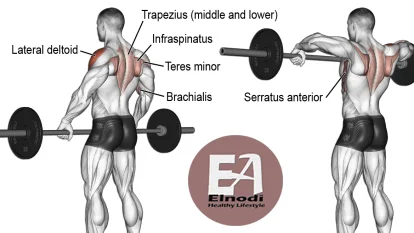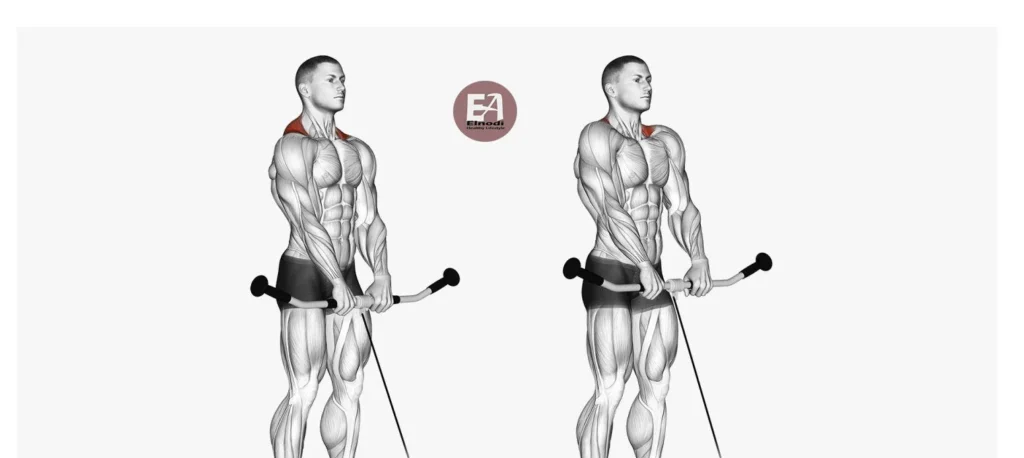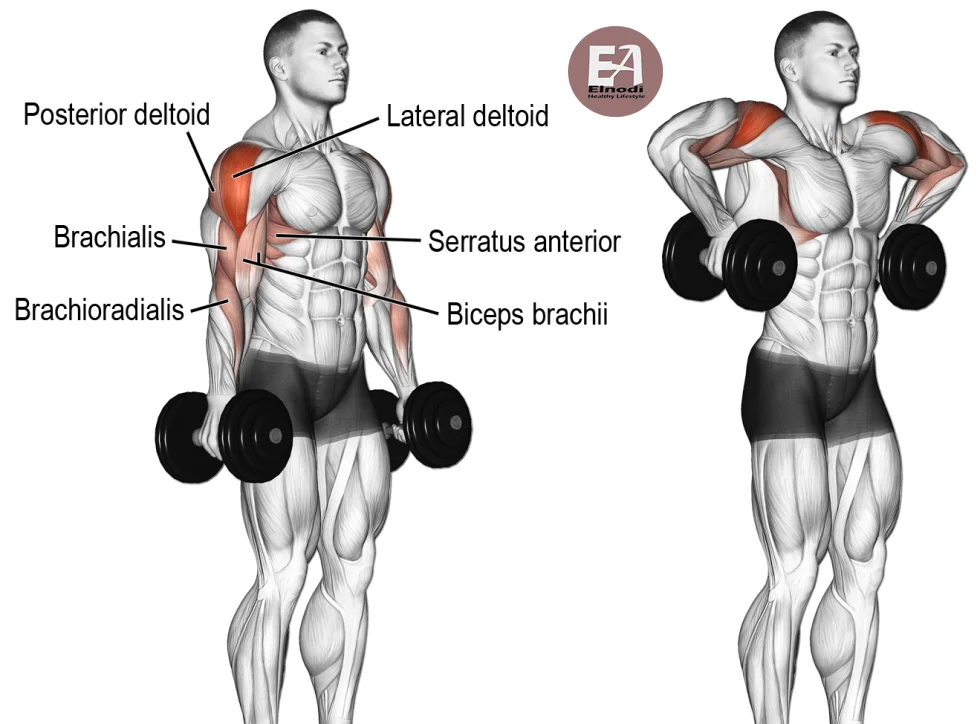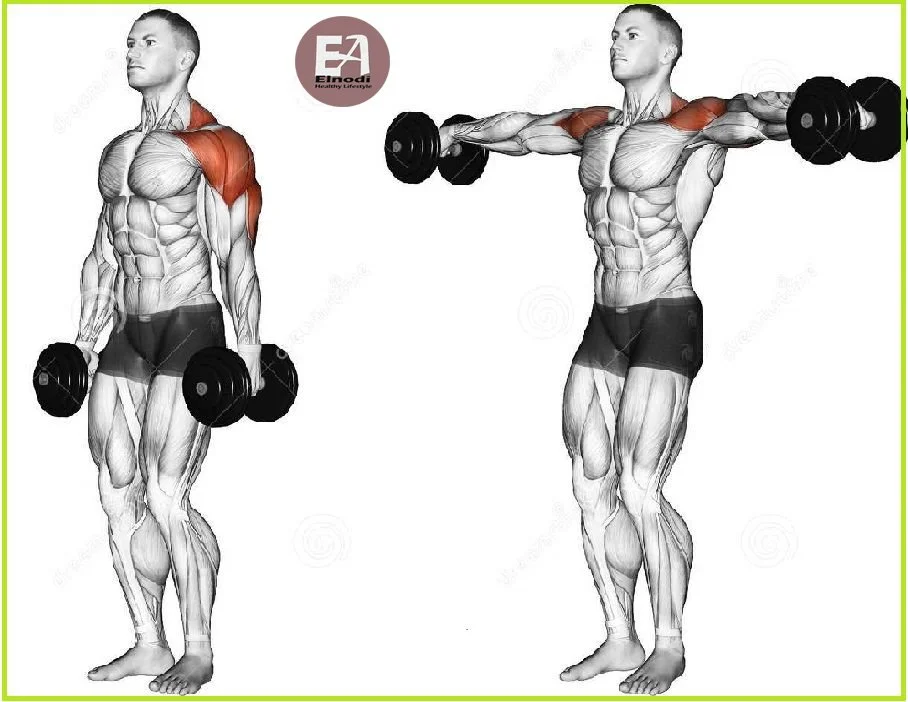The barbell upright row is one of the most popular exercises for strengthening the back. However, incorrect execution can lead to serious injury. Learn the correct way to do this exercise to avoid pain and injuries. (1)
What is Barbell Upright Row?
The barbell upright row is a compound movement that targets the entire back body. It is composed of six basic motions: abduction (lifting the weight off the ground), extension (moving the weight away from your midsection), lateral flexion (bending your side), rotation (turning your torso around), and horizontal flexion (bending your waist). (2)
Benefits of barbell Upright Row
The upright row might help you grow muscle mass in your shoulders. This maneuver may be used by exercisers to produce a more defined physique, such as when competing in bodybuilding competitions. It can also make non-competitive exercisers feel less self-conscious when their shoulder is visible, such as while wearing a sleeveless shirt.
Upright rows also contribute to increased shoulder strength. This strength makes it easier to perform everyday exercises. You may find that you can lift heavier grocery bags or that it isn’t as much of a struggle to pick up your children or grandchildren.
A barbell upright row can even help you achieve and maintain shoulder wellness. What exactly does this mean? The stronger the muscles surrounding the shoulder joint, the better it can perform its normal functions. So, healthy shoulders are powerful shoulders.
Another benefit of upright rows is that they can aid in the recovery of certain conditions. For instance, one study found that upright rows appear to help relieve chronic neck muscle pain. (The other exercise offering relief was the lateral raise.)
Some researchers have even discovered that this activity can be used to predict mortality. According to this study, a subject’s performance of the upright row exercise helped predict their approximate age of death.
As if that weren’t enough, the upright row is a compound workout, which provides additional advantages. Compound exercises allow you to work multiple muscles at once. This helps you to cut your workout time without sacrificing results.
Muscles Worked by barbell Upright Row

Because it trains multiple muscular groups at once, the upright row is classified as a compound exercise. The major aim, however, is the deltoid muscle group (shoulder muscle). The deltoids are made up of three muscle heads:
- Anterior deltoid
- Lateral deltoid
- Posterior deltoid
The barbell row targets the anterior and lateral deltoids rather than the back delts. It also works the rhomboids and trapezius muscles in the back.
The rhomboids are located beneath the trapezius muscles and help with upper limb movement. The trapezius muscle is involved in head movement and posture. The lower and upper trapezius aid in upward scapular rotation, while the middle aids in scapula adduction.
Another muscle target of upright rows is the biceps (biceps brachii). This upper arm muscle aids in the lifting and lowering motion, making the exercise a more complete upper body movement.
How to do Barbell Upright Row

Instructions
- The barbell upright row is one of the best exercises for building the upper traps and shoulders. Load up a barbell with the weight you want to use and stand facing it with your feet at around shoulder width apart.
- Grasp the barbell with an overhand grip (palms facing down), and hands slightly closer than shoulder-width apart.
- Pick the bar up, bending at the knees and keeping your back straight.
- Keeping your back straight and eyes facing forward, lift the bar straight up while keeping it as close to your body as possible (you should pull the bar up to around chest height – nearly touching your chin).
- After a little pause, steadily lower the bar back to its starting position.
- Repeat for the appropriate number of reps.
barbell upright row Tips:
- Maintain a higher elbow position than your forearms. The elbows propel the movement.
- Maintain a stiff posture for the duration of the set. When lowering the bar, don’t lean forward, and when raising it, don’t lean back. The upright row is made easier by movement, but you won’t get the most out of it.
- Pause and squeeze the traps at the height of the movement before slowly lowering the bar to increase the intensity of the workout.
Common barbell Upright Row Mistakes
Incorrect Range of Motion
As with any workout, a lack of full range of motion when completing the upright row will inhibit your outcomes. It is critical to understand your specific abilities in order to ensure a broad range of motion. Use a range of motion that causes you pain or discomfort at all times. If you suffer pain, reduce the range of motion or switch to a different activity.
Lift the bar to your clavicle for as long as you can do so safely and painlessly. Pulling to chest height will almost probably require less weight than pulling higher. A greater range of motion with less weight, on the other hand, is preferable to a greater range of motion with more weight.
Not Controlling the Descent
A typical mistake that will cause you to miss out on results is not regulating the weight as it drops. The exercise’s eccentric lowering portion is quite stimulating. It will help you grow muscle and strength if you control it rather than letting gravity take over.
Dropping weight greatly increases your risk of injury by putting strain on your shoulder joints and ligaments. It’s preferable to keep the movement under control during the pulling and lowering phases.
Bar Travelling Too Far From Your Body
Instead of arcing the bar away from your body, maintain it close by elevating your elbows up instead of out. Keeping the bar closer to your body can help you stimulate all of the muscles in your shoulder appropriately, including your side delts, which will be underutilized if you are the bar away from you.
Grip Position
If this exercise causes wrist discomfort, use a wider grip. For wrist and shoulder safety, shoulder-width apart is occasionally advised. Using a wide grip also promotes deltoid and trapezius muscle activation.
However, shoulder joints vary from person to person, so finding a grip that works for you and sticking to it is vital. Not one particular grip is best for everyone, and some people feel better using a narrow grip.
Pay attention to your joints, avoid any grip that causes pain, and note which grip appears to provide the optimum stimulation to get the most out of the workout. You should be able to feel your side delts and traps working, fatiguing, and experiencing a pump and weakness from exercising the muscles effectively.
Using Momentum
Throughout the lift, keep the body steady and the abs braced—no turning, arching, or twisting. There should be no movement at all in the legs. Maintain a straight back, a raised chest, and your gaze forward.
Use your hips and legs to generate propulsion that lifts the weight. Reduce the weight you’re lifting if you can’t get it up with the appropriate form.
Excessive Weight
Lift big weights with this workout only if you are experienced and confident in your shoulder joints. The shoulder joint is a very complicated system, and injuries to it can have a significant influence on your workout goals while also taking a long time to heal. Excessive weight might cause shoulder impingement.
If you’re new to the upright row, start with a barbell with no weight. This will give you a chance to experience the lift, learning the movement and the positioning throughout. Add weight gradually, watching that you don’t add too much weight before your shoulders are ready.
Safety and Precautions
According to the American College of Sports Medicine and the National Federation of Professional Trainers, persons of all fitness levels should avoid this exercise. Similar concerns have been expressed by the American Council on Exercise, which claims that this form of exercise can be “counterproductive to normal shoulder function.”
If you choose to do upright rows, be sure you use perfect posture and form. Better yet, choose other exercises that work these same muscles but are less dangerous to the shoulder. This includes the bench press, overhead press, and push-ups.
When exercising on the shoulders, take care not to injure the muscles. This workout is not recommended for people who have back problems. and hefty weights should be avoided. Stop exercising if you experience pain or inflammation.
When using a barbell, the “wavy” EZ curl bar makes this exercise a little easier on the wrist joints. Look for an EZ curl bar that allows you to grip the barbell at slight angles to help reduce the strain on the wrists from the angle at the top of the lift.
Barbell Upright Row Variations and Alternatives
Cable Upright Row

Because of the consistent tension supplied by the cable machine, doing the upright row in a cable machine rather than a barbell may result in a more natural movement pattern. If you think the barbell upright row is too strenuous on your shoulder joints, try the cable version instead.
Monkey Row

The monkey row is a variation on the barbell upright row that requires a wider grasp and a more outward pull. This workout may be gentler on your shoulder joints than the barbell upright row.
Dumbbell Lateral Raise

The dumbbell lateral raise is a more isolated exercise that targets the lateral deltoids directly. The upright row uses more muscles, but if you have difficulty doing it or making muscle contact with your lateral delts, the lateral rise may be a better option.
FAQs
Where should your hands be on an upright row?
Should upright rows be wide or close grip?
Are standing barbell rows good?
Is the overhand grip harder?
References
1. Graham, J. F. (2004). Barbell upright row. Strength & Conditioning Journal, 26(5), 60-61.
2. Longo, S., Corradi, A., Michielon, G., Scurati, R., Sardanelli, F., & Sconfienza, L. M. (2016). Comparing the subacromial space at 90° shoulder abduction with and without external humerus rotation and during upright row postures in young healthy subjects: an ultrasound evaluation. In European College of Sport Science: Book of abstracts (pp. 208-209). Hosted.





